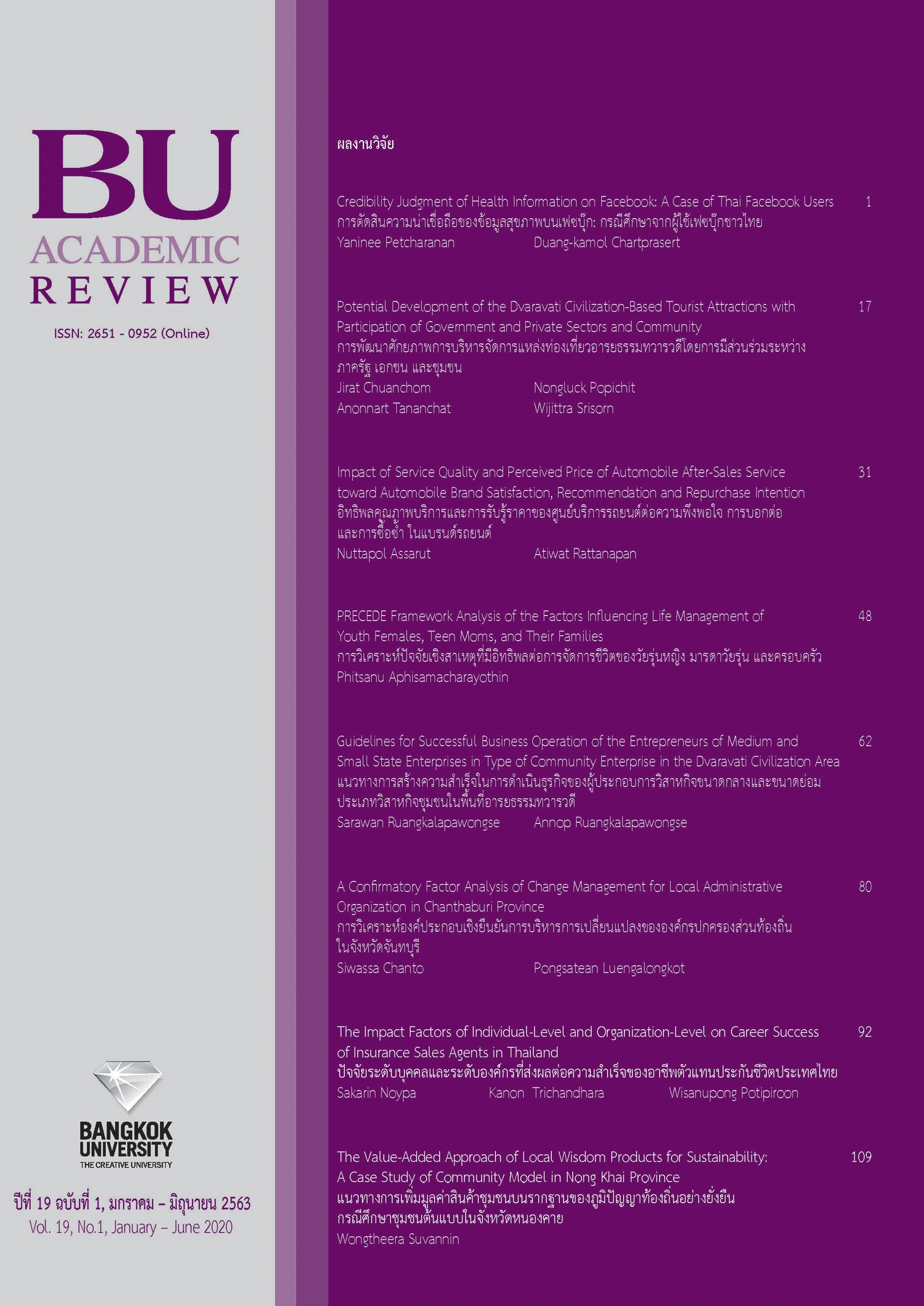Joint Buffer Zone Forest Management of the Community Area in Huai Kha Khaeng Wildlife Sanctuary
Main Article Content
Abstract
The objectives of this research are 1) to study the management and problems of common buffer forest management, and 2) to propose a strategy for managing common buffer forest of the community at Huai Kha Khaeng Wildlife Sanctuary. It is a qualitative research compiled by document research. Field research consists of in-depth interviews, uninterrupted observation, public stage measurement, activity in “eating wild rice, telling stories and listening to problems.” Forty-seven key informants were used in the study, and triangulation was conducted with checking on data collection methods. Data analysis included content analysis method and explained in a descriptive way, with emphasis on the principles of rules and regulations for resource management
The research revealed two findings. First is the exploitation of the national forest reserves, and community forests that was caused by people inside and outside of the said forests in the forms of encroaching on the ground, cutting down trees, searching for forest products, and hunting for forest reserves. Other problems included forest fire crisis in drought and problems of wild elephants invading the area and destroying horticultural crops, as well as the encroachment into Huai Kha Khaeng Wildlife Sanctuary. The second finding concerns the fact that the area of community forests and national forests that the area of is both adjacent to and not adjacent to the Huai Kha Khaeng Wildlife Sanctuary, hence carrying out activities through the community forest establishment projects approved by the Forest Department Operations in community forest areas with joint patrols. There are also discussions between the government and the community. Other projects include making a forest fire prevention line, building check dams to slow down water, planting extra trees, and setting up extraction points for preventing and monitoring violation, and all of which abide with rules for utilization in the same direction. In this aspect, spatial uses under different community factors need to establish guidelines that are based on how to be strategic in the area of Huai Kha Khaeng bumper to serve as a guideline for all practices under the new law (Community Forest Act (2019) and Wildlife Preservation and Protection Act (2019) to be a strategy of the area, of the district, and of the province).
Article Details
The manuscript submitted for publication must be the original version, submitted only to this particular journal with no prior acceptance for publication elsewhere in other academic journals. The manuscript must also not violate the copyright issue by means of plagiarism.
References
Berknuller, K., & Mukherjee, S. (1989). Buffer zones in the service of ecodevelopment. Tigerpaper, 16, 12-19.
Bunnag, C. (2011). Nǣokhit wādūai kānčhatkān sapphayākō̜n rūam: Prasopkān čhāk tāngprathēt læ nǣokhit nai prathēt Thai [The concept of shared resource management: Experience from foreign countries and concepts in Thailand]. Nonthaburi: Office of Reform.
Community Forest Act. (2019). Rātchakitčhānubēksā [Royal Thai Government Gazette]. 136, 71-103.
Faculty of Forestry Kasetsart University. (1989). Rāingān chabap sombūn phǣn mǣbot kānčhatkān khēt raksā phan satpāhūaikhākhǣng čhangwat ʻuthai thānī - Tāk [Final report, Master plan for management of Huai Kha Khaeng Wildlife Sanctuary, Uthai Thani-Tak Province]. Bangkok: The Royal Forest Department Ministry of Agriculture and Cooperatives.
Forest Act. (1941). Rātchakitčhānubēksā [Royal Thai Government Gazette]. 58, 1417-1451.
Khumsup, K. (2015). Sitthi chumchon kap kānčhatkān sapphayākō̜n thammachāt yāng yangyư̄n kō̜ranī sưksā pā chumchon nai čhangwat ʻUbon rātchathānī [Community rights and sustainable natural resources management A case study of community forest in Ubon Ratchathani province]. Journal of Political Science and Law Kalasin Rajabhat University,
(1), 141-157.
Nakwibunwong, W., Phongphrom, A., & Aphiwatthanakun, N. (2007). Kānčhatkān phư̄nthī kanchon nai prathēt Thai [Management of bumper areas in Thailand.]. Bangkok: The Thailand Research Fund (TRF).
National Reserved Forest Act. (1964). Rātchakitčhānubēksā [Royal Thai Government Gazette]. 81, 263-281.
Onprom, S. (2011). Pā chumchon: theknōlōyī ʻamnāt khūapkhum chumchon nai khēt pā chin mai ? kō̜ranī sưksā pā chumchon hūai kǣo tambon hūai kǣo ʻamphœ̄ mǣ ʻō̜n čhangwat Chīang Mai [Community forest: Technology to control the community in a new forest? A case study of Huay Kaew community forest, Huay Kaew Subdistrict, Mae On District, Chiang Mai Province]. Journal of Sociology of Anthropology, 30(2), 155-177.
Royal Decree Expanding Huai Kha Khaeng Wildlife Sanctuary. (1992). Rātchakitčhānubēksā [Royal Thai Government Gazette]. 109, 33-35.
Wildlife Conservation Information Section. (2018). Khēt satpāhūaikhākhǣng [Huay Kha Khaeng Wildlife Sanctuary]. Retrieved July 18, 2018, from http://www.dnp.go.th/wildlife_it/n_web/lacegant/menu_map/pang_HKK.php
Wildlife Preservation and Protection Act. (1992). Rātchakitčhānubēksā [Royal Thai Government Gazette]. 109, 1-22
Wildlife Preservation and Protection Act. (2019). Rātchakitčhānubēksā [Royal Thai Government Gazette]. 136, 104-144.


